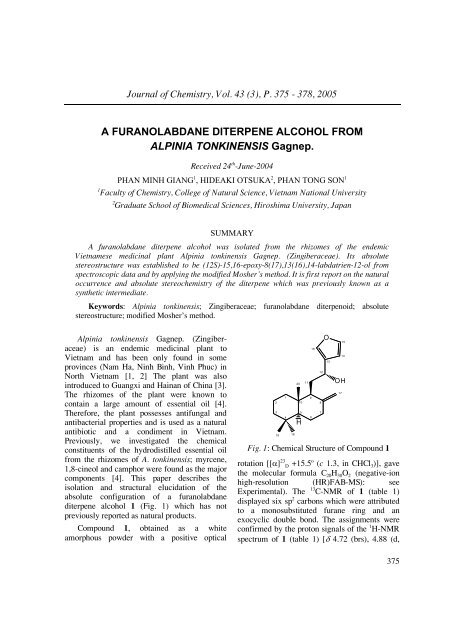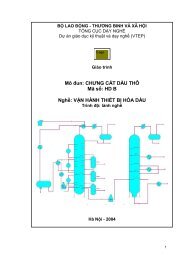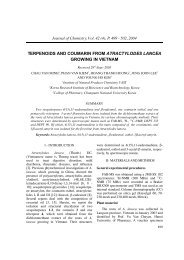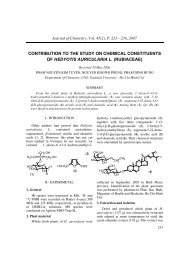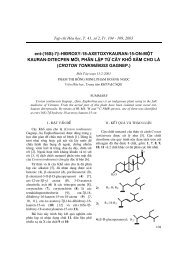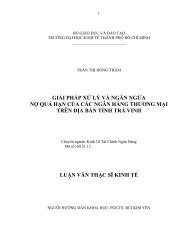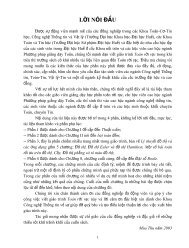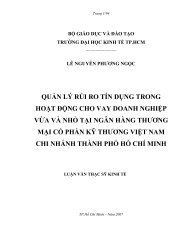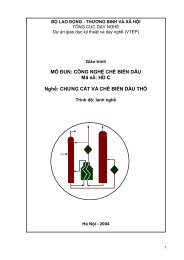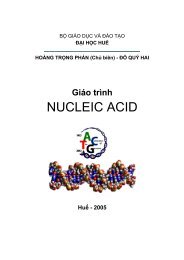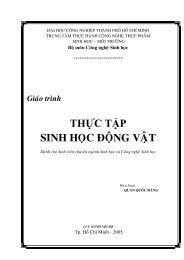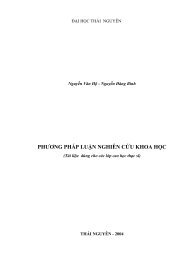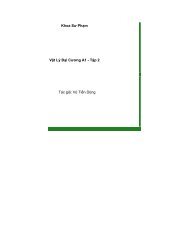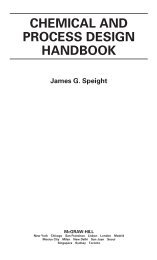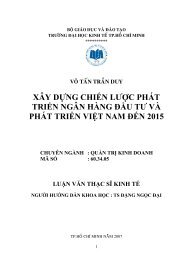A FURANOLABDANE DITERPENE ALCOHOL FROM ... - DSpace
A FURANOLABDANE DITERPENE ALCOHOL FROM ... - DSpace
A FURANOLABDANE DITERPENE ALCOHOL FROM ... - DSpace
You also want an ePaper? Increase the reach of your titles
YUMPU automatically turns print PDFs into web optimized ePapers that Google loves.
Journal of Chemistry, Vol. 43 (3), P. 375 - 378, 2005<br />
A Furanolabdane Diterpene Alcohol from<br />
Alpinia tonkinensis Gagnep.<br />
Received 24 th -June-2004<br />
Phan Minh Giang 1 , Hideaki Otsuka 2 , Phan Tong Son 1<br />
1 Faculty of Chemistry, College of Natural Science, Vietnam National University<br />
2 Graduate School of Biomedical Sciences, Hiroshima University, Japan<br />
summary<br />
A furanolabdane diterpene alcohol was isolated from the rhizomes of the endemic<br />
Vietnamese medicinal plant Alpinia tonkinensis Gagnep. (Zingiberaceae). Its absolute<br />
stereostructure was established to be (12S)-15,16-epoxy-8(17),13(16),14-labdatrien-12-ol from<br />
spectroscopic data and by applying the modified Mosher’s method. It is first report on the natural<br />
occurrence and absolute stereochemistry of the diterpene which was previously known as a<br />
synthetic intermediate.<br />
Keywords: Alpinia tonkinensis; Zingiberaceae; furanolabdane diterpenoid; absolute<br />
stereostructure; modified Mosher’s method.<br />
Alpinia tonkinensis Gagnep. (Zingiberaceae)<br />
is an endemic medicinal plant to<br />
Vietnam and has been only found in some<br />
provinces (Nam Ha, Ninh Binh, Vinh Phuc) in<br />
North Vietnam [1, 2] The plant was also<br />
introduced to Guangxi and Hainan of China [3].<br />
The rhizomes of the plant were known to<br />
contain a large amount of essential oil [4].<br />
Therefore, the plant possesses antifungal and<br />
antibacterial properties and is used as a natural<br />
antibiotic and a condiment in Vietnam.<br />
Previously, we investigated the chemical<br />
constituents of the hydrodistilled essential oil<br />
from the rhizomes of A. tonkinensis; myrcene,<br />
1,8-cineol and camphor were found as the major<br />
components [4]. This paper describes the<br />
isolation and structural elucidation of the<br />
absolute configuration of a furanolabdane<br />
diterpene alcohol 1 (Fig. 1) which has not<br />
previously reported as natural products.<br />
Compound 1, obtained as a white<br />
amorphous powder with a positive optical<br />
2<br />
3<br />
19<br />
1<br />
4<br />
18<br />
20<br />
10<br />
5<br />
H<br />
11<br />
9<br />
6<br />
16<br />
12<br />
8<br />
7<br />
O<br />
13<br />
15<br />
14<br />
OH<br />
Fig. 1: Chemical Structure of Compound 1<br />
rotation [[] 23 D +15.5 o (c 1.3, in CHCl 3 )], gave<br />
the molecular formula C 20 H 30 O 2 (negative-ion<br />
high-resolution (HR)FAB-MS): see<br />
Experimental). The 13 C-NMR of 1 (table 1)<br />
displayed six sp 2 carbons which were attributed<br />
to a monosubstituted furane ring and an<br />
exocyclic double bond. The assignments were<br />
confirmed by the proton signals of the 1 H-NMR<br />
spectrum of 1 (table 1) [ 4.72 (brs), 4.88 (d,<br />
17<br />
375
1.4) of the exocyclic double bond, 6.42 (brd,<br />
1.2), 7.41 (t, 1.2) and7.34 (brs) of the furane<br />
ring]. A secondary alcohol group was found to<br />
be in the structure of 1 on the basis of the signal<br />
at H 4.71, C 66.3 (based on the correlation in<br />
the HMQC spectrum of 1). Furthermore, three<br />
singlet signals of tertiary methyl groups ( 0.70,<br />
0.78, and 0.83) were seen in the 1 H-NMR<br />
spectrum of 1. Taken all together, 1 was<br />
suggested as a labdane-type diterpenoid with an<br />
exocyclic double bond at the 8-position.<br />
Comparison of the 13 C-NMR spectroscopic data<br />
of 1 with the known labd-8(17)-enes [5, 6]<br />
disclosed the location of the hydroxyl group in<br />
the alicyclic side chain (C-11C-16). The<br />
coupling constant of the secondary carbinol<br />
proton (dd, J = 9.6, 4.8) clearly indicated the<br />
location of the group at C-12 since the furane<br />
ring was attached to C-13. The HMBC spectrum<br />
of 1, as shown in Fig. 2, was in full agreement<br />
with the suggested structure. Generally, the<br />
labdane-type diterpenes are characteristic of the<br />
genus Alpinia [7]. The diterpene 1, therefore,<br />
was also assigned to the normal labdane-type<br />
diterpenoids and determined to be 15,16-epoxy-<br />
8(17),13(16),14-labdatrien-12-ol, but the<br />
absolute stereochemistry at the 12-position<br />
remained to be elucidated.<br />
376<br />
O<br />
OH<br />
Fig. 2: HMBC Correlations (HC) of<br />
Compound 1<br />
Literature search showed the presence of<br />
two diastereoisomeric hydroxides, prepared<br />
semisynthetically [8, 9], owing to the<br />
asymmetric center at the 12-position, but their<br />
absolute stereochemistry remained in doubt.<br />
Compound 1 showed the NMR data (table 1)<br />
superimposable with those of one of the<br />
diastereomers, and thus is the first reported<br />
natural product possessing 15,16-epoxy-<br />
8(17),13(16),14-labdatrien-12-ol structure.<br />
Table 1: 1 H-NMR and 13 C-NMR Spectroscopic<br />
data of compounds 1<br />
(CDCl 3 , in ppm, J in parentheses in Hz) a)<br />
C/H<br />
13 C<br />
1<br />
1 H<br />
1<br />
0.80 m<br />
38.9<br />
<br />
1.70 brd (13.1)<br />
2<br />
1.44 m<br />
19.4<br />
<br />
1.55 qt (13.8, 3.2)<br />
3<br />
1.10 ddd (13.8, 13.3, 4.2)<br />
42.1<br />
<br />
1.35 brd (13.3)<br />
4 33.6<br />
5 55.4 0.98 dd (12.6, 2.8)<br />
6<br />
1.69 m<br />
24.4<br />
<br />
1.31 qd (12.6, 4.2)<br />
7<br />
1.90 m<br />
38.3<br />
<br />
2.37 ddd (12.6, 4.2, 2.3)<br />
8 149.1<br />
9 53.1 1.42 brd (11.2)<br />
10 39.6<br />
11<br />
1.93 m<br />
32.0<br />
<br />
1.90 m<br />
12 66.3 4.71 dd (9.6, 4.8)<br />
13 128.9<br />
14 108.3 6.42 brd (1.2)<br />
15 143.5 7.41 t (1.2)<br />
16 139.7 7.34 brs<br />
17A<br />
4.72 brs<br />
106.7<br />
B<br />
4.88 d (1.4)<br />
18 33.5 0.83 s<br />
19 21.7 0.78 s<br />
20 14.6 0.70 s<br />
a) Assignments were made on the basis of the HMQC<br />
and HMBC experiments
The secondary function of the alcohol group<br />
at C-12 allowed us to determine the absolute<br />
stereochemistry at C-12 applying the modified<br />
Mosher’s method [10]. Treatment of 1 with (R)-<br />
and (S)--methoxy--trifluoromethylphenylacetic<br />
acid (MTPA) in the presence of 1-ethyl-<br />
3-(3-dimethylaminopropyl)carbodiimide hydrochloride<br />
(EDC) and 4-dimethylaminopyridine<br />
(DMAP) afforded the 12-(R)- and 12-(S)-MTPA<br />
esters (1a and 1b, respectively) [11] The<br />
chemical shifts for the proton signals of 1a and<br />
1b were assigned by comparison with the<br />
spectroscopic data of 1 and<br />
1 H- 1 H COSY<br />
experiments. The differences in the 1 H chemical<br />
shifts between the diastereomers 1b and 1a (<br />
= S R ) indicated an S-configuration for C-12<br />
and therefore the absolute stereostructure of 1<br />
was determined to be (12S)-15,16-epoxy-<br />
8(17),13(16),14-labdatrien-12-ol. In the<br />
NOESY spectrum of 1 (Fig. 3), no NOEs were<br />
observed between H-12 and H-9, and between<br />
H-12 and H 3 -20. The NOE interaction between<br />
H-12 and H-17A ( 4.72; H-17B appeared at <br />
4.88 showing a NOE interaction with H-7 at <br />
2.37) (dotted line) was possible but uncertain to<br />
be confirmed in CDCl 3 since their overlapping<br />
signals ( 4.71 and 4.72, respectively).<br />
H<br />
H<br />
H<br />
H 3 C<br />
H CH 3<br />
H<br />
H<br />
H<br />
CH 3<br />
H<br />
Fig. 3: NOESY Correlations of Compound 1<br />
General Procedure<br />
Experimental<br />
H<br />
H<br />
H<br />
HO<br />
H<br />
H<br />
H<br />
H<br />
H A<br />
H B<br />
Optical rotation was measured on a Union<br />
Giken PM-101 digital polarimeter. 1 H-NMR<br />
(500 MHz) and 13 C-NMR (100 MHz) spectra<br />
were obtained on JEOL JNM-ECP 500 and<br />
JEOL JNM -400 NMR spectrometers,<br />
respectively, with tetramethylsilane as an<br />
internal standard. Negative-ion mode spectrum<br />
of 1 was recorded on a JEOL JMS SX-102.<br />
Preparative HPLC was carried out with JASCO<br />
PU-1580 pump and UV-2075 Plus detector (set<br />
at 210 nm) on an YMC ODS column (150×20<br />
mm i.d.) at the flow rate of 5 ml/min. Silica gel<br />
60 (0.063 - 0.200 mm, Merck) was used for<br />
open column chromatography. TLC was carried<br />
out on pre-coated TLC plates (Kieselgel 60 F 254 ,<br />
MERCK Art. 5747), and detected by spraying<br />
with 10% H 2 SO 4 in 50% EtOH followed by<br />
heating on a hot plate at 200 o C. (R)- and (S)-<br />
MTPAs were purchased from Nacalai Tesque<br />
Co., Ltd.<br />
Plant material<br />
The fresh rhizomes of A. tonkinensis<br />
Gagnep. (4 kg) were collected in Vinh Phuc<br />
Province, Vietnam, in August 2003. The plant<br />
was identified by Mr Nguyen Quoc Binh, a<br />
botanist of the Institute of Ecology and<br />
Biological Resources, Vietnam National Center<br />
for Natural Science and Technology, Hanoi,<br />
Vietnam. A voucher specimen (No. VN1295)<br />
was deposited in the Herbarium of the same<br />
Institute.<br />
Extraction and Isolation<br />
The powdered dried rhizomes of A.<br />
tonkinensis were extracted three times with<br />
MeOH by percolation at room temperature.<br />
Removal of the solvent from the combined<br />
MeOH extracts gave a black sirup (22.3 g). This<br />
sirup was suspended in water and partitioned<br />
with solvents of increasing polarity (n-hexane,<br />
EtOAc, and 1-BuOH). The n-hexane-soluble<br />
fraction (5.5 g) was subjected to a silica gel<br />
column chromatography eluted with n-hexane-<br />
EtOAc solvent systems (9 : 1, 8 : 1, 4 : 1 and<br />
EtOAc), six fractions were collected on the<br />
basis of TLC spots. Fraction 4 (160 mg) was<br />
chomatographed on silica gel using n-hexane-<br />
EtOAc (9 : 1) as solvent system, the main<br />
377
subfraction was purified by HPLC on an ODS<br />
column using MeOHH 2 O (4 : 1) as solvent<br />
system to afford compound 1 (12 mg).<br />
(12S)-15,16-epoxy-8(17),13(16),14-<br />
labdatrien-12-ol (1): Amorphous powder. [] 23 D<br />
+15.5 o (c 1.3, CHCl 3 ). 1 H-NMR (CDCl 3 ) and<br />
13 C-NMR (CDCl 3 ): Table 1. HRFAB-MS<br />
(negative-ion mode) m/z : 301.2189 (Calcd for<br />
C 20 H 29 O 2 : 301.2168).<br />
Preperation of 12-(R)- and 12-(S)-MTPA<br />
esters of 15,16-epoxy-8(17),13(16),14-<br />
labdatrien-12-ol (1a and 1b, respectively): see<br />
reference 11.<br />
Acknowledgements: This research was<br />
supported by the International Foundation for<br />
Science, Stockholm, Sweden, through a Grant to<br />
Dr. Phan Minh Giang, and the Basic Research<br />
Program in Natural Science of Vietnam.<br />
References<br />
1. Pham H. H. An Illustrated Flora of<br />
Vietnam, Published by the Author,<br />
Montreal, Tome III, Fascicle 1, P. 547<br />
(1993).<br />
2. Nguyen Q. B. Vietnam Journal of Biology,<br />
16(4), P. 143 - 145 (1994).<br />
3. Flora Online: http://flora.huh.harvard.edu.<br />
4. Phan M. G., Phan T. S. and Koenig W. A.<br />
Flavour and Fragrance Journal, submitted<br />
paper.<br />
5. H. Itokawa, S. Yoshimoto and H. Morita.<br />
Phytochemistry, 27, 435 (1988).<br />
6. H. Itokawa, H. Morita, I. Katou, K. Takeya,<br />
A. J. Cavalheiro, R. C. B. De Olivera, H.<br />
Ishige and M. Motidome. Planta Medica,<br />
54, 311 (1988).<br />
7. S. Tesaki, H. Kikuzaki, S. Yonemori and N.<br />
Nakatani. J. Nat. Prod., 64, P. 515 - 517<br />
(2001).<br />
8. M. Jung, I. Ko and S. Lee. J. Nat. Prod., 61,<br />
1394 - 1396 (1998).<br />
9. J. Willamizar, J. Fuentes, F. Salazar, E.<br />
Tropper, and R. Alonso. J. Nat. Prod., 66, P.<br />
1623 - 1627 (2003).<br />
10. I. Ohtani, T. Kusumi, Y. Kashman, H.<br />
Kakisawa J. Am. Chem. Soc., 113, P. 4092 -<br />
4096 (1991).<br />
11. Otsuka H., Hirata E., Shinzato T., Takeda<br />
Y., Phytochemistry, 62, P. 763 - 768 (2003).<br />
378


